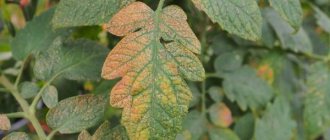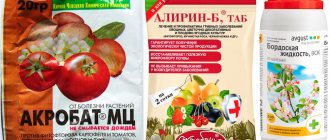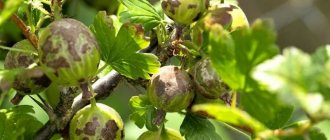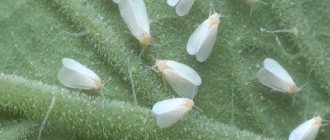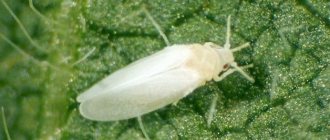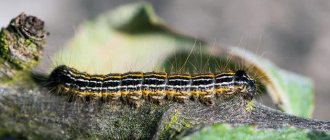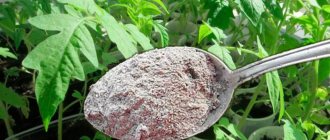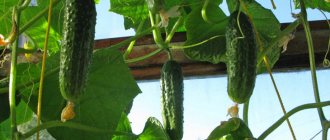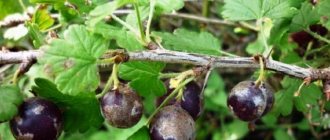What kind of disease is this
Fusarium is a dangerous fungal disease of tomatoes that is resistant to chemicals . Its distribution indicates errors in growing plants. The disease can be encountered both in greenhouses and in open ground in all climatic regions. It may take 2-3 weeks from the onset of the disease to the complete death of the plant.
How does it affect tomatoes?
The fungus attacks the vascular system of seedlings, as a result of which the roots and fruits begin to rot, and the plant itself begins to dry out. The photo shows that the disease spreads from bottom to top. The fungus can be found in the soil and enters the plant through damaged or small roots. As the disease progresses, rot appears on the root system, and fungi penetrate through the vessels into the stem and leaves.
The first sign of Fusarium wilt of seedlings is the falling of the lower leaves. However, this symptom is characteristic of many other ailments. Fusarium is accompanied by discoloration of the petioles and curling of the foliage.
Experienced gardeners have noticed that most often the disease affects plants grown in greenhouse conditions. However, if all conditions for tomato growth are met (temperature, humidity, lighting), it can be avoided. Fusarium wilt is also typical for seedlings grown year after year in the same place.
Prevention measures in greenhouses
Sometimes gardeners explain the infection of tomatoes by the fact that in open ground they are more susceptible to various negative factors. But when grown in a greenhouse, no less problems await them. The impact of low temperatures disappears, but the problem of crop rotation, air stagnation and high humidity appears.
Therefore, greenhouse owners need to follow some rules to obtain a high yield of tomatoes:
- When growing tomatoes in a greenhouse, the soil should be changed as often as possible, preferably once a year.
- The air temperature during the day should be between 22 and 24 degrees, at night not lower than 16 and not higher than 18 degrees.
- Humidity should be no higher than 65 percent.
- Do not water the beds too much.
- In hot weather, greenhouse glass is painted over with chalk.
- Tomatoes are planted in the same place only after three to four years, or the soil is changed every year.
- A greenhouse for tomatoes is not placed in the place where potatoes grew a couple of years before. They have common diseases.
Description of symptoms and external signs
It is very difficult to recognize fusarium in a timely manner, since its symptoms are similar to those of other diseases or soil depletion. Novice gardeners, not understanding the true reason for the drying out of tomatoes, begin to use various fertilizers that do not have an effect and can harm the plant.
Manifestations:
- pale green or yellow leaves;
- discoloration of the veins along which the plant sap moves;
- deformation of leaf petioles;
- leaf curling;
- falling of the lower leaves;
- gradual withering of the plant;
- the formation of white plaque on the roots at high humidity.
First, the lower leaves turn yellow and fall off, then the upper part of the green mass begins to change color, dry out and become deformed. The disease can be recognized by cutting the stem - the vessels become brown in color. If an infected plant is kept in a room with high humidity for several days, white mycelium of the fungus will be visible.
Peculiarity . The disease can be recognized only during flowering or fertilization of plants. During this period, the main phase of withering occurs.
Causes of appearance and infection
Fusarium is a fungal disease that not only parasitizes the plant, but also causes it to dry out. To select the correct treatment, you need to understand the nature of the pathogen and determine the conditions for its spread.
The causative agent of the disease
The causative agent is fungi of the genus Fusarium, living in the soil at a depth of 10 cm . Getting inside the plant, they affect its vascular system, in particular the veins through which juices circulate.
Fungi, when multiplying, completely clog these channels, which disrupts the nutrition of the green mass of the seedlings. Since the causative agent of the disease is inside the plant, it is very difficult to completely eliminate it without harming the tomato.
Microorganisms release compounds that negatively affect the condition of the leaves. As a result, they begin to curl and then fall off.
Important ! The causative agent of the disease is resistant to various chemicals, so it is very difficult to cope with it.
The fungus can remain in the soil and plant debris for a very long time, which can lead to infection of new crops.
Terms of distribution
The pathogen can be in the substrate, on garden tools, in seeds and soil. Pathogenic fungi do not interfere with the development of seedlings until conditions favorable for their spread are established.
Symptoms of the disease begin to manifest themselves clearly during the period when there are changes in air temperature: hot days give way to cold nights. If the temperature drops to 16°C, the plants will begin to rapidly die. Increased humidity promotes the active proliferation of fungi that attack the stems and leaves of plants.
Low nutrient content in the soil and errors in plant care can cause the spread of the disease. Growing seedlings in one place also creates favorable conditions for the proliferation of fungi.
Factors predisposing to fusarium:
- crowded beds;
- excessive use of chemicals;
- non-compliance with crop rotation;
- location of the site in a place where groundwater is close to the groundwater;
- shortening daylight hours;
- poor lighting in the greenhouse;
- drought, drying out of plant roots;
- close location to the garden of industrial zones.
Distribution methods:
- Through seeds - when the seed material is infected, the plant begins to dry out even during the period of fruit formation.
- Through roots - fungi located in the soil are introduced into the plant through damage to the root system.
Attention ! The pathogen can enter tomatoes through minor damage caused during pinching or transplanting.
Improper feeding of plants
Agronomists argue that the organization of the fertilizing process seriously affects the development of many crops. Moreover, not only a low amount of nutrients will be harmful, but also their excess.
To determine exactly what substances tomatoes lack, you should look at exactly which parts of the plant are wilting. In the case when old leaves turn yellow, fertilizing with zinc, magnesium and molybdenum should be organized.
Many people are interested in why the tops of tomatoes wither and what fertilizers should be applied. In this case, the plant lacks one of the following elements:
- manganese;
- chlorine;
- boron;
- calcium;
- iron;
- sulfur.
It is enough to add those substances that are deficient in order to resume normal growth of tomatoes.
How and with what to treat
Fusarium is a disease that must be treated. If left untreated, all plants may die. However, since the causative agent of the disease is resistant to chemicals, it is very difficult to cure tomatoes.
Important ! There is no point in treating severely damaged tomatoes - they are uprooted and burned.
Chemicals
Medicines against fusarium can be chemical or biological. Biological ones do not contain chemical components; they are bacteria that can neutralize pathogenic fungi. Such products are considered quite effective, as they saturate the soil with beneficial microorganisms, which reduces the likelihood of the appearance of dangerous bacteria.
At the first signs of the development of Fusarium wilt, the biological drug Trichodermin is effective. For one bush of an adult plant, 0.5 liters of solution is enough; the drug is poured under the root. This product is also suitable for preventive soil treatment before planting seedlings: 1 kg of product per 10 square meters. m.
Biological agents to combat the disease also include Trichocin, Alirin-B, and Gamair. Planriz and Pseudobacterin-2 are suitable for watering sick plants. 100 ml of solution is consumed per bush.
Chemical preparations are more effective than biological ones, but have a significant drawback: after treatment, you cannot eat fruits from a diseased plant for several weeks. Experts recommend applying the treatment no later than three weeks before harvest.
You can spray the affected leaves of the plant with the preparation “Falcon” - 1 mg of the product is needed for 3.3 liters of water. The procedure is carried out using a fine spray, treating the stem and leaves on both sides. The drugs Previkur, Strekar, Benazol and Fundazol also showed good results in the treatment of fusarium.
Traditional methods
Practice has shown that it is possible to stop the development of Fusarium wilt without the use of special drugs. To make the fruits as environmentally friendly and safe as possible, you can use dolomite flour or lime. The products are generously laid out on the beds.
For watering and spraying, you can use a solution of manganese or preparations containing copper.
Agrotechnical techniques
Following the rules of crop rotation allows you to avoid many diseases. They involve regularly changing the site for growing tomatoes. Tomatoes can be planted in their original place only after 3-4 seasons. Good predecessors for nightshades are cabbage, pumpkin and cucumber. But it’s better not to plant tomatoes in place of eggplants, peppers, potatoes and physalis.
If the gardener does not have the opportunity to plant seedlings in another place, and the disease has already appeared earlier, then when buying seeds it is worth choosing varieties that are resistant to the fungus.
These include:
- De Barao;
- Blitz;
- Orco F1;
- Raisa;
- Pink Giant;
- Monica;
- Rusich;
- Rhapsody;
- Sun;
- Sorento;
- Plot;
- Senzafin F1;
- Martin;
- Charisma F1;
- Carlson;
- Spartak F1;
- Miron F1;
- Vologda F1;
- Ural F1.
Moderate use of fertilizers will also promote healthy plant growth. Before planting seedlings, it is recommended to fertilize the soil abundantly using natural ingredients: compost or manure. If the gardener does not have the opportunity to fertilize with organic substances, then nitrogen-containing preparations can be used.
Treatment
Fusarium is a dangerous fungal disease . The pathogenic fungi that cause this disease are very resistant to the chemicals used. It is important to start treatment in time before the disease affects the entire plant.
Folk remedies
At the first manifestations of the disease, folk remedies are used to protect tomato seedlings. This makes it possible to slow down the development of the disease without the use of chemicals.
- Physarium mushrooms do not like alkaline environments . Therefore, to avoid disease, seedlings are watered with an infusion of wood ash. To do this, pour a glass of ash into a bucket of water, mix thoroughly and pour the warm solution over the soil around the seedlings.
- Garlic has a bad effect on the vital activity of mushrooms . Chop the head of garlic and add a glass of water. The mixture is infused for a day, after which it is mixed in 10 liters of water and sprayed on tomato seedlings. Spray in the morning or evening so that direct sunlight does not burn the leaves.
- In a liter of milk, soften a quarter of a piece of pre-grated laundry soap, add 30 drops of iodine and treat the plants with this composition. This should be done every day until the signs of the disease disappear.
Folk remedies are more suitable for preventive measures; in advanced cases of the disease they will not bring the desired effect.
Chemicals
To treat tomato seedlings, the chemicals Previkur, Maxim or Quadris are used.
- Previcur solution . To prepare the solution, dissolve 15 ml of the drug in 10 liters of water and water the seedlings at the root. The treatment is repeated after 2 weeks. Previkur works better when growing seedlings in greenhouses. The cost of the drug is 40 rubles per 100 gram sachet.
- The drug Maxim is used for treating the soil before planting seedlings at the rate of 20 ml of the drug per 10 liters of water. To treat seedlings, dilute 4 ml of fungicide in 2 liters of water. The diluted composition is stored for no more than a day. The seedlings are sprayed and the treatment is repeated after a week. The product is safe to use indoors. The price of a 2 ml sachet costs 32 rubles.
- The drug Quadris is used to treat seedlings in a greenhouse at the rate of 4 ml per 1 liter of water. Treatment with this drug is carried out twice with an interval of two weeks.
Biological drugs
Tomato seedlings are also treated with biological preparations.
These products contain beneficial microorganisms that destroy pathogenic fungi and do not harm human health.
Such drugs for the treatment of Fusarium include Fitosporin, Trichodermin and Alirin.
- Fitosporin M – a biological preparation that contains special stabilizing additives (dormant bacteria) that suppress the proliferation of pathogenic fungi. This is a systemic drug, it spreads throughout the plant’s vascular system.
Dilute it in a concentration of 5 g of powder per 10 liters of water. The resulting solution is sprayed onto the seedlings.The drug cannot be used in bright sunlight, as this kills Bacillus subtilis bacteria, which are the basis of Fitosporia M.
- Trichodermin . The drug contains the Trichoderma fungus, which suppresses the development of soil pathogenic fungi. To prepare a solution, 20 g of the drug is diluted in 10 liters of water. The composition is sprayed on seedlings and watered the soil once every 2 weeks.
- Alirin is similar in composition to Fitosporin M. A solution is prepared from it at the rate of 2 tablets per 1 liter of water for spraying and 2 tablets per 10 liters of water for watering seedlings.
Other control methods
- To combat fusarium, adding a large amount of dolomite flour to the soil will help. It is applied before planting seedlings.
- Since pathogenic fungi do not like an alkaline environment, lime is added to the soil.
- An effective remedy would be to treat the soil with a solution of potassium permanganate. This is done before planting seedlings.
- For diseases in the early stages, spray with Bordeaux mixture.
- Spraying the seedlings with a copper-soap solution, prepared by dissolving 2 g of copper sulfate and 200 g of laundry soap in 10 liters of water, helps well.
Preventive measures
It is impossible to completely get rid of fusarium; its causative agent may still remain in the vascular system of the plant. Planting disease-resistant tomatoes does not guarantee protection against fungus.
Prevention:
- cleaning the area from plant residues after harvesting;
- preparing the land for planting seeds: digging, disinfecting, loosening;
- disinfection of seed material: heating or treatment with fungicides;
- regular ventilation of the greenhouse;
- providing additional lighting;
- disinfection of garden tools and garter material;
- mulching beds;
- carrying out pinching using pruning shears;
- regular hilling of seedlings.
Advice from gardeners
The disease mainly affects plants grown in greenhouses. You can reduce the risk of disease by regularly ventilating the room after evening watering. It would be useful to equip it with a good ventilation system.
Pre-planting seed treatment is the key to plant health. The material must be treated with drugs belonging to the group of benzimidazoles, for example, “Fundazol” or “Benazol”. Disinfection is carried out two weeks before planting; 5-6 g of product will be needed per 1 kg of seeds. The drug is dissolved in water, after which the solution is poured into a spray bottle. Seeds placed in a container are sprayed and mixed. 20-30 minutes after the procedure, the material is scattered to dry and then placed into bags.
According to reviews from summer residents, the development of the disease can be avoided by carrying out additional treatment of the roots. The root system of the seedlings is dipped into the fungicide solution for a few seconds, after which they need to be dried a little and planted in the garden bed.
Pre-planting soil treatment can also protect against Fusarium wilt. For disinfection, you can use copper sulfate: 70 g of the product is dissolved in one bucket of water. Dolomite flour or chalk will also help neutralize fungi.
It has been observed that pathogenic fungi do not respond well to mulching. Most summer residents use straw for these purposes, but you can also try putting black film on the beds - the material inhibits pathogens.
After harvesting, the gardener needs to clear the area of vegetation and disinfect the soil. For these purposes, use lime, potassium permanganate solution or a mixture of ash and powdered sulfur.
Disinfection of planting material
Spores of a pathogenic fungus may exist on the surface of the seeds . Therefore, the seeds must be prepared.
- Most often, potassium permanganate is used to disinfect tomato seeds before sowing seedlings, which is diluted at the rate of 1 mg per 1 liter of water and the seeds are soaked for 15 minutes.
- A 3% solution of hydrogen peroxide, in which the seeds are soaked for 20 minutes, disinfects seeds well.
- Fitosporin M is used to disinfect seeds. Half a teaspoon of powder is diluted in 100 ml of water. The seeds are soaked in the resulting solution for 2 hours before planting. You can also keep the root system of seedlings in this solution.
